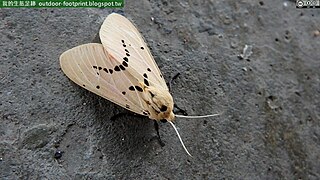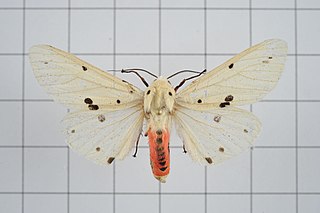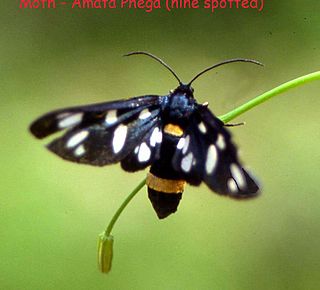
The buff ermine is a moth of the family Erebidae. It is sometimes placed in the genus Spilosoma. The species was first described by Johann Siegfried Hufnagel in 1766. It is found throughout the temperate belt of the Palearctic region south to northern Turkey, Georgia, Kazakhstan, southern Siberia, eastern Mongolia, Amur Region, China, Korea and Japan.

The Thyrididae comprise the family of picture-winged leaf moths. They are the only family in the superfamily Thyridoidea, which sometimes has been included in the Pyraloidea, but this isn't supported by cladistic analysis.

The Spilosomina are a subtribe of tiger moths in the tribe Arctiini, which is part of the family Erebidae.

Spilarctia is a genus of moths in the family Erebidae. The genus was erected by Arthur Gardiner Butler in 1875.
Anatrachyntis incertulella, the pandanus flower moth, is a small cosmet moth species. It belongs to subfamily Cosmopteriginae. This was the first "micromoth" species to be described from Hawaiʻi. The type specimens were collected there by the 1820s Beechey expedition and described by the English entomologist Francis Walker in 1864; they are now in the British Museum of Natural History.
Phiditiidae is a family of moths. The family used to be placed as a subfamily (Phiditiinae) in the family Bombycidae.

Spilosoma obliqua, the jute hairy caterpillar or Bihar hairy caterpillar, is a moth of the family Erebidae. It is found in south-eastern Afghanistan, northern Pakistan, India, Bhutan, Bangladesh and Myanmar.
Scopula subcarnea is a moth of the family Geometridae. It is found in India.
Spilarctia bisecta is a moth in the family Erebidae. It was described by John Henry Leech in 1889. It is found in China.
Spilarctia leopardina is a moth in the family Erebidae. It was described by Vincenz Kollar in 1844. It is found in Tibet, Nepal, the north-western Himalayas and Kashmir.
Spilarctia seriatopunctata is a moth in the family Erebidae. It was described by Motschulsky in 1861. It is found in Russia, China, Korea and Japan.
Spilarctia nydia is a moth in the family Erebidae. It was described by Arthur Gardiner Butler in 1875. It is found in Nepal, China, Taiwan and northern Vietnam.

Spilarctia alba is a moth in the family Erebidae. It was described by Otto Vasilievich Bremer and William Grey in 1853. It is found in China, Taiwan and Korea.
Spilarctia bipunctata is a moth in the family Erebidae. It was described by Franz Daniel in 1943. It is found in Yunnan and Sichuan in China.
Spilarctia comma is a moth in the family Erebidae. It was described by Francis Walker in 1856. It is found in Tibet in China and in Bhutan.
Spilarctia sparsalis is a moth in the family Erebidae. It was described by Francis Walker in 1865. It is found on Sulawesi.
Spilarctia rubescens is a moth in the family Erebidae. It was described by Francis Walker in 1855. It is found in Myanmar, China (Yunnan) and on Sumatra.
Spilarctia strigatula is a moth in the family Erebidae. It was described by Francis Walker in 1855. It is found in Sundaland, Thailand, Nepal and Myanmar.

The Syntomini are a tribe of moths in the family Erebidae. The tribe was erected by Gottlieb August Wilhelm Herrich-Schäffer in 1846.







